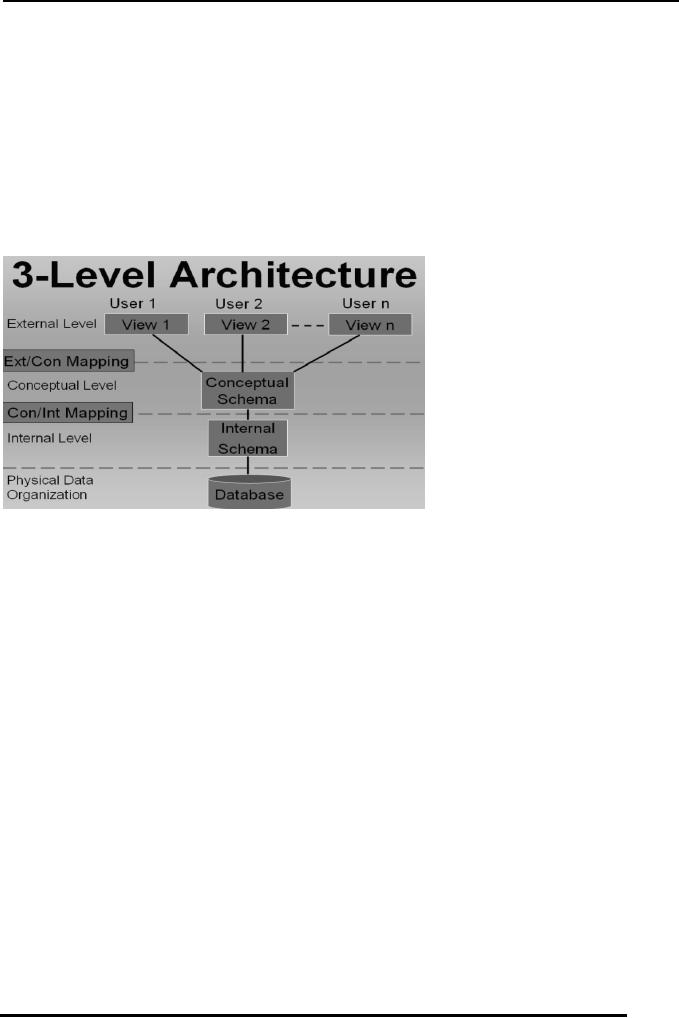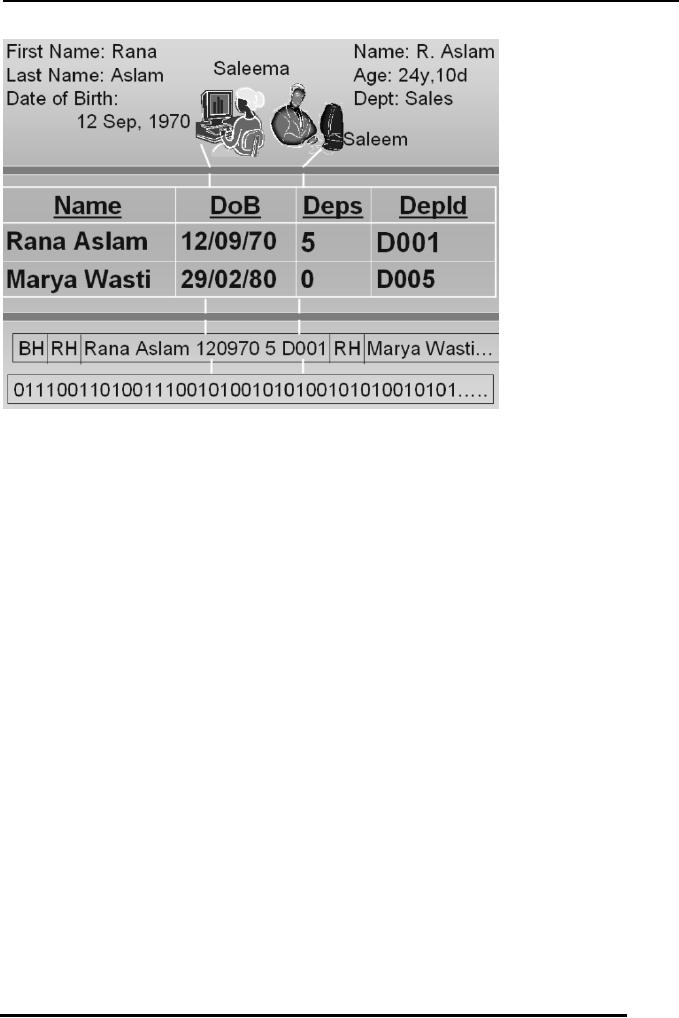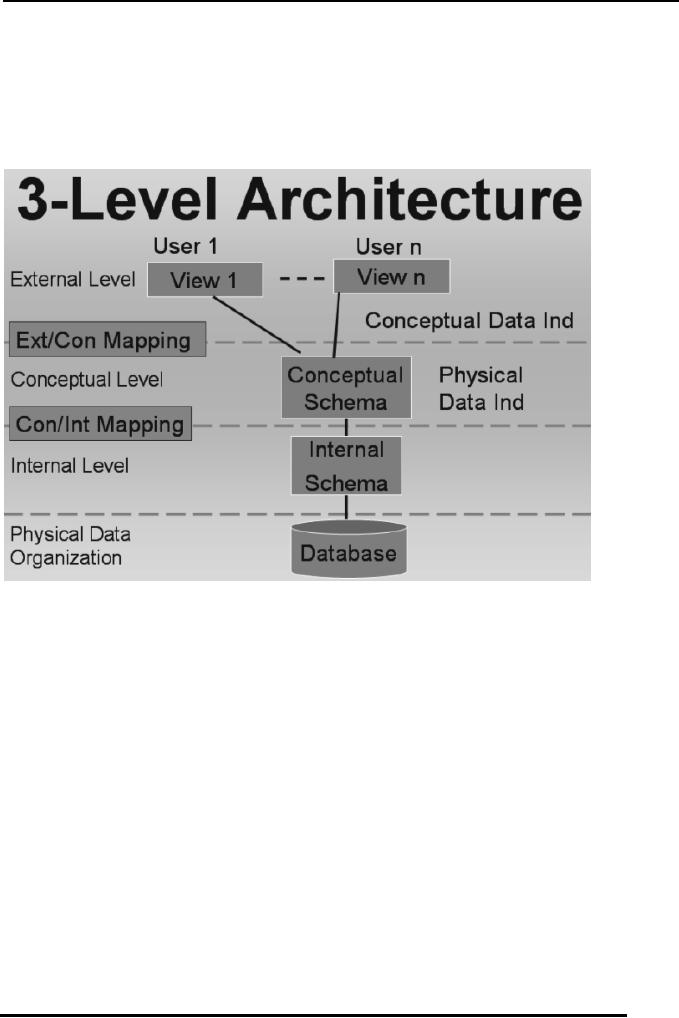 |

Database
Management System
(CS403)
VU
Lecture No.
04
Reading
Material
"Database
Systems
Principles,
Design
and
4.1.3,
Implementation"
written by Catherine Ricardo, 4.1.4
Maxwell
Macmillan.
Hoffer
Chapter
2
Overview of
Lecture
o Internal Schema of
the Database Architecture
o Data
Independence
o Different aspects of
the DBMS
Internal or Physical
View / Schema
This is the level of
the database which is responsible for the storage
of data on the
storage media and places the data in such a format
that it is only
readable by the DBMS. Although the internal view
and
the physical view are
so close that they are generally referred to a
single layer of the
DBMS but there lays thin line which actually
separated the
internal view from the physical view. As we know that
data when stored onto
a magnetic media is stored in binary format,
because this is the
only data format which can be represented
electronically, No
matter what is the actual format of data, either
text, images, audio
or video. This binary storage mechanism is
always implemented by
the Operating System of the Computer.
DBMS to
some extent decides the way data is to be stored on
the
disk. This decision
of the DBMS is based on the requirements
specified by the
DBA when implementing the database. Moreover
the DBMS
itself adds information to the data which is to be stored.
For example a
DBMS has selected a specific File
organization for the
40

Database
Management System
(CS403)
VU
storage of data on
disk, to implement that specific file system
the
DBMS
needs to create specific indexes. Now whenever the
DBMS will
attempt to retrieve
the data back form the file organization system
it will use the same
indexes information for data retrieval. This
index information is
one example of additional information which
DBMS
places in the data when storing it on the disk. At the same
level storage
space utilization if performed so that the data can
be
stored by consuming
minimum space, for this purpose the data
compression can be
performed, this space optimization is achieved
in such a way that
the performance of retrieval and storage process
is not compromised.
Another important consideration for the storage
of data at the
internal level is that the data should be stored in
such a way that it is
secure and does not involve any security risks.
For this purpose
different data encryption algorithms may be used.
Lines below detail
further tidbits of the internal level.
The difference
between the internal level and the external level
demarcates a boundary
between these two layers, now what is that
difference, it in
fact is based on the access or responsibility of
the
DBMS for
the representation of data. At the internal Level the
records are presented
in the format that are in match with schema
definition of the
records, whereas at the physical level the data is
not strictly in
record format, rather it is
in character
format.,
means the rules
identified by the schema of the record are not
enforced at this
level. Once the data has been transported to the
physical level it is
then managed by the operating system. Operating
system at that level
uses its own data storage utilities to place the
data on
disk.
Inter Schema
Mapping:
The mechanism through
which the records or data at one level is
related to the
changed format of the same data at another level is
known as mapping.
When we associate one form of data at the
external level with
the same data in another form is know as the
external/conceptual
mapping of the data. (We have seen examples
of
external/conceptual mapping in the previous lecture)
In
the
same way when data at
the conceptual level is correlated with the
same data at the
internal level, this is called the conceptual/Internal
mapping.
Now the question
arises that how this mapping is performed.
Means
how is it possible to
have data at one level in date format and at a
higher level the same
data show us the age. This hidden mechanism,
conversion system or
the formula which converts the date of birth
of an employee into
age is performed by the mapping function and
41

Database
Management System
(CS403)
VU
it is defined in the
specific ext/con mapping, for example, when the
data at the
conceptual level is presented as the age of the employee
is done by the
external schema of that specific user. Now in
this
scenario the ext/con
mapping is performing the mapping with the
internal view and is
retrieving the data in desire format of the user.
In the same way the
mapping between an internal view and
conceptual view is
performed.
The figure below
gives a clear picture of this mapping process and
informs where the
mapping between different levels of the database
is
performed.
Fig:
1:
Mapping
between
External/Conceptual
and
Conceptual/Internal
levels
In Figure-1 we can
see clearly where the mapping or connectivity
is
performed between
different levels of the database management
system. Figure-1 is
showing another very important concept that the
internal layer and
the physical layers lie separately the Physical
layer is
explicitly used for data storage on
disk and is the
responsibility of the
Operating system. DBMS has almost no concern
with the details of
the physical level other than that it passes on
the
data along-with
necessary instructions required to the store that
data to the operating
system.
Figure-2 on the next
page shows how data appears on different
levels of the
database architecture and also at that of physical level.
We can clearly
see that the data store on the physical level is
in
binary format and is
separate from the internal view of data in
location and format.
Separation of the physical level from the
internal level is of
great use in terms of efficiency of storage and
data
retrieval.
42

Database
Management System
(CS403)
VU
Fig: 2.
Representation of data at different levels of data
base
Architecture and at
the physical level at bottom
At the internal level
we can see that data is prefixed with Block
Header and Record
header RH, the Record header is prefixed to
every record and the
block header is prefixed to a group of records;
because the block
size is generally larger than the record size, as
a
result when an
application is producing data it is not stored record
wise on the disk
rather block wise which reduces the number of disk
operations and
in-turn improves the efficiency of writing process.
Data
Independence:
Data Independence is
a major feature of the database system and
one of the most
important advantages of the Three Level Database
Architecture.
As it has been discussed already that
the file
processing system
makes the application programs and the data
dependent on each
other, I-e if we want to make a change in the
data we will have to
make or reflect the corresponding change in
the associated
applications also.
The Three Level
Architecture facilitates us in such a way that data
independence is
automatically introduced to the system. In other
words we can say the
data independence is major most objective of
the Three Level
Architecture. If we do not have data independence
then whenever there
will be a change made to the internal or
43

Database
Management System
(CS403)
VU
physical level
or the data accessing strategy the
applications
running at the
external level will demand to be changed because
they will not be able
to properly access the changed internal or
physical levels any
more. As a result these applications will stop
working and
ultimately the whole system may fail to operate.
The Data
independence achieved as a result of the three level
architecture proves
to be very useful because once we have the
data , database and
data applications independent of each other we
can easily make
changes to any of the components of the system,
without
effecting the functionality and operation of
other
interrelated
components.
Data and
program independence is on advantage of
the 3-L
architecture the
other major advantage is that ant change in the
lower level of the
3-L architecture does not effect the structure or
the functionality on
upper levels. I-e we get external/conceptual
and
conceptual/internal independence by the three
levels
Architecture.
Data independence can
be classified into two type based on the
level at which the
independence is obtained.
Logical Data
Independence
o
Physical Data
Independence
o
Logical data
independence
Logical
data independence provides the independence in a way that
changes in conceptual
model do not affect the external views. Or
simply it can be
stated at the Immunity of external level from
changes at conceptual
level.
Although we have data
independence at different levels, but we
should be careful
before making a change to anything in database
because not all
changes are accepted transparently at different
levels. There may be
some changes which may cause damage or
inconsistency in the
database levels. The changes which can be
done transparently
may include the following:
o Adding a file to the
database
o Adding a new field in
a file
o Changing the type of
a specific field
But a change which
may look similar to that of the changes stated
above could cause
problems in the database; for example: Deleting
an attribute from the
database structure,
44

Database
Management System
(CS403)
VU
This could be serious
because any application which is using this
attribute may not be
able to run any more. So having data
independence
available to us we still get problem after a certain
change, it means that
before making a certain change its impact
should also be kept
in mind and the changes should be made while
remaining
in
the
limits
of
the
data
independence.
Fig:3. The
levels where
the
Conceptual
and
Physical
data
independence are
effective
Physical Data
Independence
Physical data
independence is that type of independence that
provides us changes
transparency between the conceptual and
internal levels. I-e
the changes made to internal level shall not
affect the conceptual
level. Although the independence exist but as
we saw in the
previous case the changes made should belong to
a
specific
domain and should not exceed the liberty offered by the
physical data
independence. For example the changes made to the
file organization by
implementing indexed or sequential or random
access
at a later stage, changing the storage media, or simply
implement a different
technique for managing file indexes or hashes.
Functions of
DBMS
o Data
Processing
45

Database
Management System
(CS403)
VU
A user accessible
Catalog
o
Transaction
Support
o
Concurrency Control
Services
o
Recovery
Services
o
Authorization
Services
o
Support for Data
Communication
o
Integrity
Services
o
DBMS
lies at the heart of the course; it is the most
important
component of a
database system. To understand the functionality of
DBMS it
is necessary that we understand the relation of database
and the
DBMS and the dissection of the set of functions the
DBMS
performs on the data
stored in the database.
Two important
functions that the DBMS performs are:
User
management
Data
Management
The detailed
description of the above two major activities of
DBMS
is given
below;
o Data
Processing
By Data management we
mean a number of things it may include
certain operations on
the data such as: creation of data, Storing of
the data in the
database, arrangement of the data in the databases
and data-stores,
providing access to the data in the database,
and
placing of the data
in the appropriate storage devices. These action
performed on the data
can be classified as data processing.
o A User Accessible
Catalog
DBMS has
another very important task known as access proviso
to
catalog. Catalog is
an object or a place in the DBMS which stores
almost all of the
information of the database, including schema
information, user
information right of the users, and many more
things about the
database. Modern relational DBMS require that
the
Administrative users
of the database should have access to the
catalog of the
database.
o Transaction
Support
DBMS is
responsible for providing transaction support. Transaction
is an action that is
used to perform some manipulation on the data
stored in the
database. DBMS is responsible for supporting all
the
required
operations on the database, and also
manages the
46

Database
Management System
(CS403)
VU
transaction execution
so that only the authorized and allowed
actions are
performed.
o Concurrency
Support
Concurrency support
means to support a number of transactions to
be executed
simultaneously, Concurrency of transactions is managed
in such a way that if
two or more transaction is making certain
processing on the
same set of data, in that case the result of all
the
transactions should
be correct and no information should be lost.
o Recovery
Services
Recovery services
mean that in case a database gets an
inconsistent
state to get
corrupted due to any invalid action of someone, the
DBMS
should be able to recover itself to a consistent state,
ensuring
that the data loss
during the recovery process of the database
remains
minimum.
o Authorization
Services
The database is
intended to be used by a number of users, who will
perform a number of
actions on the database and data stored in the
database, The
DBMS is used to allow or restrict different
database
users to interact
with the database. It is the responsibility of the
database to check
whether a user intending to get access to
database is
authorized to do so or not. If the user is an authorized
one than what actions
can he/she perform on the data?
o Support for Data
Communication
The DBMS
should also have the support for communication of the
data indifferent
ways. For example if the system is working for such
an organization which
is spread across the country and it is
deployed over a
number of offices throughout the country, then the
DBMS
should be able to communicate to the central database
station. Or if the
data regarding a product is to be sent to the
customers worldwide
it should have the facility of sending the data
of the product in the
form of a report or offer to its valued
customers.
o Integrity
Services
Integrity means to
maintain something in its truth or originality. The
same concept applies
to the integrity in the DBMS environment.
Means the
DBMS should allow the operation on the database
which
are real for the
specific organization and it should not allow
the
false information or
incorrect facts.
47

Database
Management System
(CS403)
VU
DBMS
Environments:
o Single
User
o Multi-user
� Teleprocessing
� File
Servers
� Client-Server
o Single User Database
Environment
This is the database
environment which supports only one user
accessing
the database at a specific time. The DBMS might have
a
number of users but
at a certain time only one user can log into the
database system and
use it. This type of DBMS systems are also
called Desktop
Database systems.
o Multi-User Database
systems
This is the type of
DBMS which can support a number of users
simultaneously
interacting with the database indifferent ways. A
number of
environments exist for such DBMS.
� Teleprocessing
This type of Multi
user database systems processes the user
requests at a central
computer, all requests are carried to the
central computer
where the database is residing, transactions are
carried out and the
results transported back to the terminals
(literally dumb
terminals). It has become obsolete now.
� File
Servers
This type of
multi-user database environment assumes another
approach for sharing
of data for different users. A file server is used
to maintain a
connection between the users of the database system.
Each
client of the network runs its own copy of the DBMS and
the
database
resides on the file server. Now whenever a user
needs
data from the
file server it makes a request the whole file
containing the
required data was sent to the client. At this stage it
is important to
see that the user has requested one or two
records
from the database but
the server sends a complete file, which might
contain hundreds of
records. Now if the client after making the
desired operation on
the desired data wants to write back the data
on the database he
will have to send the whole file back to the
server, thus causing
a lot of network overhead. The Good thing
about this approach
is that the server does not have lots of actions
to do rather it
remains idle for lots of the time in contrast with that
of the teleprocessing
systems approach.
� Client-Server
48

Database
Management System
(CS403)
VU
This type of
multi-user environment is the best implementation of
the network and
DBMS environments. It has a DBMS server
machine
which runs the
DBMS and to this machine are connected the
clients
having application
programs running for each user. Once a users
wants to perform a
certain operation on data in the database it
sends its requests to
the DBMS through its machine's application
software; the request
is forwarded to the DBMS server which
performs the required
operation on data in the database stored in
the dame computer and
then passes back the result to the user
intending the result.
This environment is best suited for large
enterprises where
bulk of data is processed and requests are very
much
frequent.
This
concludes the topics discusses in the lecture No4.In
the next
lecture Database
application development process will be
discussed
Exercises:
- Extend the
format of data from the exercise of previous
lecture to
include the physical and internal
levels.
Complete your
exercise by including data at all three
levels
- Think of
different nature of changes at all three levels of
database architecture
and see, which ones will have no
effect on
the existing applications, which will
be
adjusted in the
inter-schema mapping and which will
effect the existing
applications.
49
Table of Contents:
- Introduction to Databases and Traditional File Processing Systems
- Advantages, Cost, Importance, Levels, Users of Database Systems
- Database Architecture: Level, Schema, Model, Conceptual or Logical View:
- Internal or Physical View of Schema, Data Independence, Funct ions of DBMS
- Database Development Process, Tools, Data Flow Diagrams, Types of DFD
- Data Flow Diagram, Data Dictionary, Database Design, Data Model
- Entity-Relationship Data Model, Classification of entity types, Attributes
- Attributes, The Keys
- Relationships:Types of Relationships in databases
- Dependencies, Enhancements in E-R Data Model. Super-type and Subtypes
- Inheritance Is, Super types and Subtypes, Constraints, Completeness Constraint, Disjointness Constraint, Subtype Discriminator
- Steps in the Study of system
- Conceptual, Logical Database Design, Relationships and Cardinalities in between Entities
- Relational Data Model, Mathematical Relations, Database Relations
- Database and Math Relations, Degree of a Relation
- Mapping Relationships, Binary, Unary Relationship, Data Manipulation Languages, Relational Algebra
- The Project Operator
- Types of Joins: Theta Join, Equi–Join, Natural Join, Outer Join, Semi Join
- Functional Dependency, Inference Rules, Normal Forms
- Second, Third Normal Form, Boyce - Codd Normal Form, Higher Normal Forms
- Normalization Summary, Example, Physical Database Design
- Physical Database Design: DESIGNING FIELDS, CODING AND COMPRESSION TECHNIQUES
- Physical Record and De-normalization, Partitioning
- Vertical Partitioning, Replication, MS SQL Server
- Rules of SQL Format, Data Types in SQL Server
- Categories of SQL Commands,
- Alter Table Statement
- Select Statement, Attribute Allias
- Data Manipulation Language
- ORDER BY Clause, Functions in SQL, GROUP BY Clause, HAVING Clause, Cartesian Product
- Inner Join, Outer Join, Semi Join, Self Join, Subquery,
- Application Programs, User Interface, Forms, Tips for User Friendly Interface
- Designing Input Form, Arranging Form, Adding Command Buttons
- Data Storage Concepts, Physical Storage Media, Memory Hierarchy
- File Organizations: Hashing Algorithm, Collision Handling
- Hashing, Hash Functions, Hashed Access Characteristics, Mapping functions, Open addressing
- Index Classification
- Ordered, Dense, Sparse, Multi-Level Indices, Clustered, Non-clustered Indexes
- Views, Data Independence, Security, Vertical and Horizontal Subset of a Table
- Materialized View, Simple Views, Complex View, Dynamic Views
- Updating Multiple Tables, Transaction Management
- Transactions and Schedules, Concurrent Execution, Serializability, Lock-Based Concurrency Control, Deadlocks
- Incremental Log with Deferred, Immediate Updates, Concurrency Control
- Serial Execution, Serializability, Locking, Inconsistent Analysis
- Locking Idea, DeadLock Handling, Deadlock Resolution, Timestamping rules